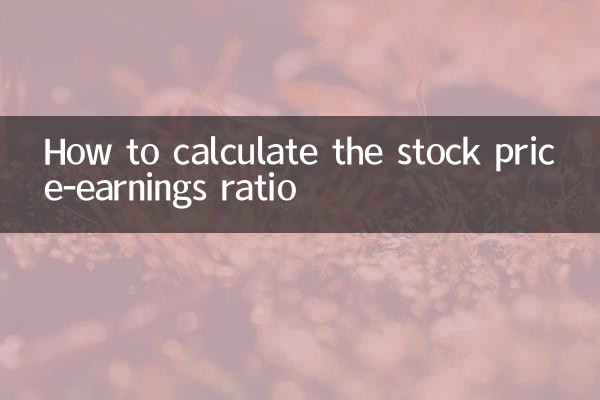How to calculate the stock price-earnings ratio
When investing in stocks, the price-to-earnings ratio (PE Ratio) is a very important indicator that can help investors evaluate the valuation level of a stock. This article will introduce in detail the calculation method of price-to-earnings ratio, and combine popular topics and hot content in the past 10 days to help readers better understand this concept.
1. Definition of price-to-earnings ratio

Price-to-Earnings Ratio (PE) is the ratio of stock price to earnings per share (EPS). It reflects the price investors are willing to pay for each unit of income and is an important indicator for measuring the valuation of a stock.
2. Calculation formula for price-earnings ratio
The calculation formula for the price-to-earnings ratio is as follows:
| formula | illustrate |
|---|---|
| Price-to-earnings ratio = Stock price / Earnings per share (EPS) | Stock price refers to the current market price, and earnings per share refers to the company's net profit for the past 12 months divided by the total share capital. |
3. Category of price-earnings ratio
The price-to-earnings ratio can be divided into three types: static price-to-earnings ratio, dynamic price-to-earnings ratio and rolling price-to-earnings ratio:
| type | illustrate |
|---|---|
| Static P/E ratio | Based on earnings per share over the past 12 months. |
| Dynamic P/E ratio | Calculated based on forecast earnings per share for the next 12 months. |
| Rolling P/E ratio | Based on the earnings per share calculation in the last 4 quarters, also known as the TTM price-to-earnings ratio. |
4. P/E ratio practical application
The price-to-earnings ratio can reflect the valuation level of the stock. Generally speaking, stocks with lower P/E ratios may be undervalued, while stocks with higher P/E ratios may be overvalued. However, the level of the P/E ratio also needs to be comprehensively judged based on the industry average and the company's growth.
For example, the tech industry is usually higher because the market expects it to grow faster in the future; while the traditional industry is usually lower because its room for growth is limited.
5. The relationship between popular topics and price-to-earnings ratio in the past 10 days
Recently, global stock markets have fluctuated significantly, especially the price-to-earnings ratios of technology stocks and new energy stocks have changed significantly. Here are some hot topics from the past 10 days:
| Hot Topics | Changes in price-to-earnings ratio of related stocks |
|---|---|
| Fed rate hike expectations | Technology stocks with high price-to-earnings ratio generally fell, and the market risk aversion sentiment heated up. |
| New energy vehicle sales growth | The price-to-earnings ratio of new energy vehicle companies such as Tesla remains high, reflecting the market's optimistic expectations for their future growth. |
| The semiconductor industry is short | The price-to-earnings ratio of semiconductor companies such as TSMC has increased, and the market is optimistic about their long-term profitability. |
6. Limitations of P/E ratio
Although the P/E ratio is an important valuation indicator, it also has certain limitations:
Therefore, when investors use the price-to-earnings ratio, they also need to conduct a comprehensive analysis based on other financial indicators and industry characteristics.
7. Summary
The price-to-earnings ratio is a core indicator in stock investment. By calculating the ratio of stock price to earnings per share, investors can help judge the valuation level of a stock. However, the price-to-earnings ratio is not omnipotent. Investors need to combine various factors such as industry background and company growth to make more scientific investment decisions.
I hope this article can help you better understand the calculation methods and application scenarios of price-to-earnings ratio. If you have other questions, please leave a message to discuss!

check the details

check the details